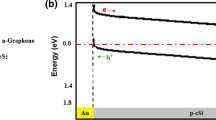Abstract
Silicon nanowire (SiNW) hybrid solar cell has been fabricated using PEDOT:PSS and rGO-PEDOT:PSS as the organic hole transport layer. The electrical characterization of the as-fabricated solar cell was done by both dark and photo J–V characteristic curves. Vertically aligned arrays of SiNWs have been synthesized by following the electroless metal-assisted chemical etching method, as confirmed by both the scanning electron microscopy and atomic force microscopy images. The structural properties of SiNWs, PEDOT:PSS and rGO-PEDOT:PSS were characterized with the help of X-ray diffraction and Raman characterization techniques. The bandgap of PEDOT:PSS comes out to be 1.77 eV as obtained from the UV–visible and photoluminescence spectra. In addition, the bandgap of PEDOT:PSS was 1.76 eV and for reduced graphene oxide (rGO) it was 0.04 eV, as obtained from the cyclic voltammetry curve. rGO-PEDOT:PSS heterojunction showed excellent J–V characteristic property in the dark and under the illumination of 1 sun. Hence the incorporation of rGO in PEDOT:PSS can improve the photovoltaic properties by increasing the conductivity of the hole transport layer, making a good interface between organic–inorganic heterojunction as well as by reducing the recombination of electron–hole pairs.













Similar content being viewed by others
References
Moiz S A, Alahmadi A N M and Aljohani A J 2020 Energies 13 3797
Bhujel R, Rizal U, Agarwal A, Swain B S and Swain B P 2018 J. Mater. Eng. Perform. 27 2655
Li P, Mohamed M I O, Xu C, Wang X and Tang X 2020 Org. Electron. 78 105582
Wang J, Wang H, Prakoso A B, Togonal A S, Hong L, Jiang C et al 2015 Nanoscale 7 4559
Wang H, Wang J, Hong L, Tan Y H and Tan C S 2016 Nanoscale Res. Lett. 11 1
Shen R, Liu M, Zhou Y, Li F, Wang H, Yang Y et al 2017 Sol. RRL 1 1
Singh E and Nalwa H S 2015 RSC Adv. 5 73575
Jiang X, Wang Z, Han W, Liu Q, Lu S, Wen Y et al 2017 Appl. Surf. Sci. 407 398
Van Trinh P, Hong P N, Thang B H, Hong N T, Thiet D V, Van Chuc N et al 2017 Adv. Mater. Sci. Eng. 2017 Article ID 2362056
Park Y, Choi K S and Kim S Y 2012 Phys. Status Solidi Appl. Mater. Sci. 209 1363
Wang S, Huang X, Sun H and Wu C 2017 Nanoscale Res. Lett. 12 619
Park M U, Song M, Lee S M, Ryu S and Chung D-W 2018 J. Nanosci. Nanotechnol. 18 6147
Lee J and Choi W 2015 J. Electrochem. Soc. 162 A935
Mohsennia M, Bidgoli M M and Boroumand F A 2015 J. Nanophoton. 9 093081
Anh N N, Chuc N V, Thang B H, Nhat P V, Hao N, Phuong D D et al 2020 Glob. Chall. 4 2000010
Shafiee A, Salleh M M and Yahaya M 2011 Sains. Malays. 40 173
Tiwari D C, Dwivedi S K, Dipak P and Chandel T 2018 AIP Conf. Proc. 1953 3
Meiss J, Uhrich C L, Fehse K, Pfuetzner S, Riede M K and Leo K 2008 Photonics Sol. Energy Syst. II 7002 700210
Hilal M and Han J I 2018 Sol. Energy 174 743
Yu X, Shen X, Mu X, Zhang J, Sun B, Zeng L et al 2015 Sci. Rep. 5 1
Acknowledgement
We acknowledge Dr Ramdas Pai and Vasanthi Pai’s endowment fund for supporting financially to carry out this whole project work.
Author information
Authors and Affiliations
Corresponding author
Rights and permissions
About this article
Cite this article
Bhujel, R., Rai, S., Deka, U. et al. Bandgap engineering of PEDOT:PSS/rGO a hole transport layer for SiNWs hybrid solar cells. Bull Mater Sci 44, 72 (2021). https://doi.org/10.1007/s12034-021-02376-8
Received:
Accepted:
Published:
DOI: https://doi.org/10.1007/s12034-021-02376-8




